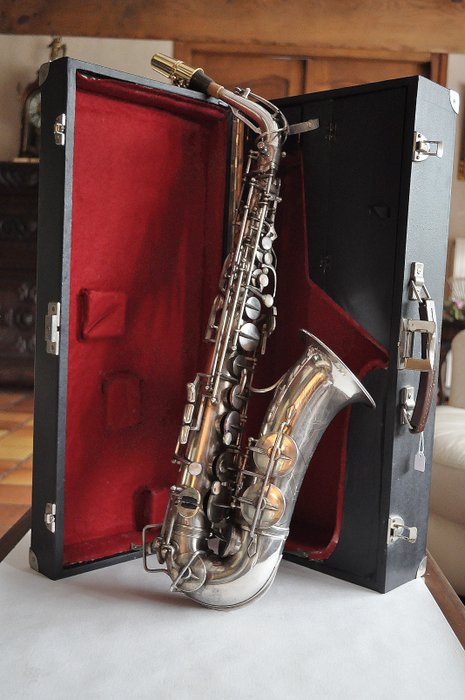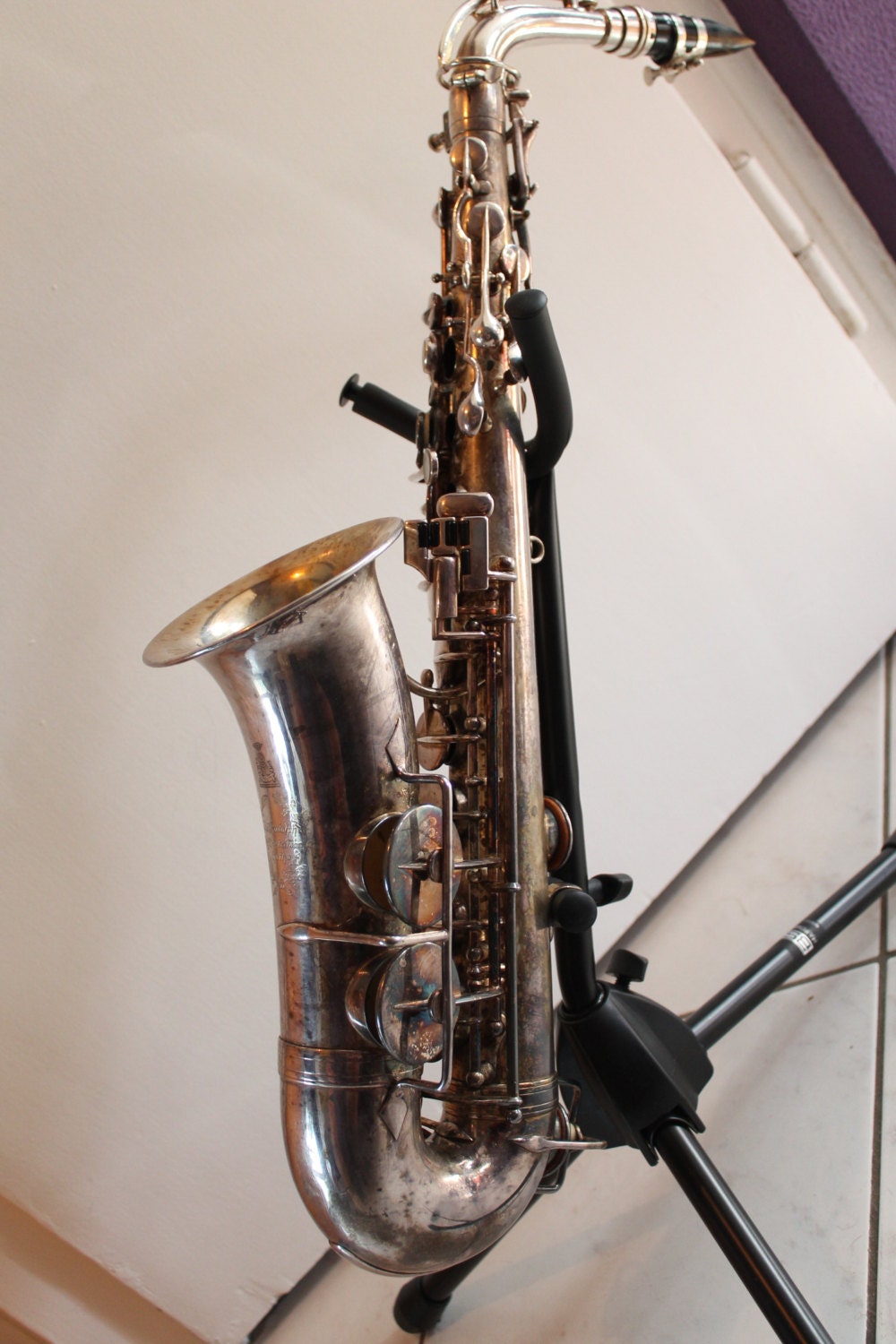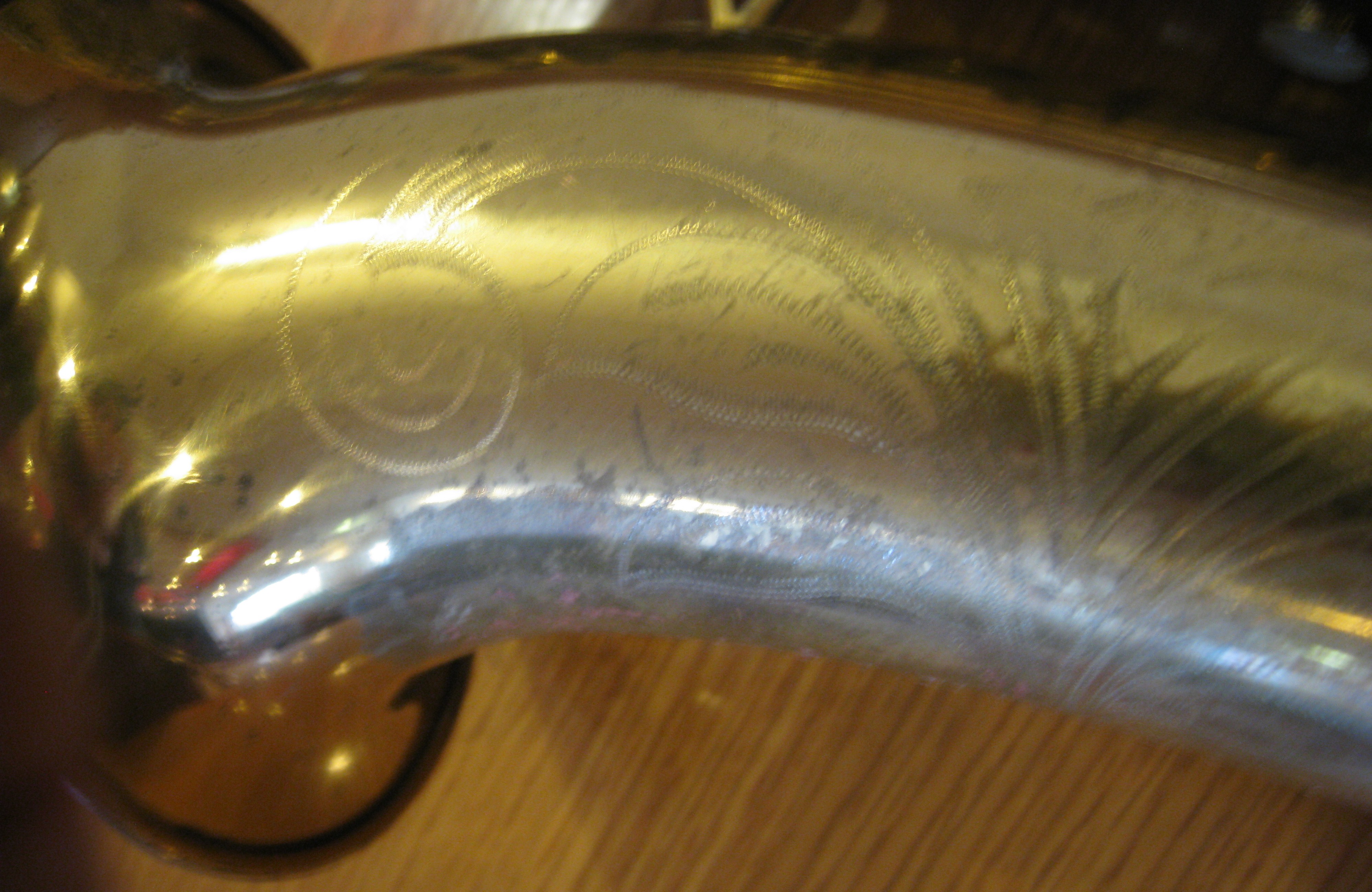I am trying to overhaul / restore a Dolnet. After some research I suspect that it is a series II. The serial number is 27581. I actually have a question about the colored accents on the key guards and the colored key inlays and whether this is a silver-plated or a nickel-plated saxophone. Make – Dolnet; Model – Belair; Serial Number – 33115C; Date of Manufacture – 1947; Place of Manufacture – Mantes, Paris, France; Finish – Gold lacquer; Weight – 5lb 3oz; Sound – Rich and deep; Ease of Blowing – Wide and full; Ease of Fingering – Well balanced; More about Dolnet saxophones can be found currently on the Web. I am trying to overhaul / restore a Dolnet. After some research I suspect that it is a series II. The serial number is 27581. I actually have a question about the colored accents on the key guards and the colored key inlays and whether this is a silver-plated or a nickel-plated saxophone.

I play a Dolnet Royal Jazz tenor, serial number 41XXX. This is the only tenor i've owned, being a baritone player originally and only moving to play tenor seriously in the last 2 years. Have however played a large number of tenors, including some very nice balanced action and mark VI selmers.
VINTAGE SAXOPHONE VALUE GUIDE
When I set out to prepare a reference guide for pricing vintage horns, I did so with the clear understanding that it’s not a perfect world, and that the preparation of a perfect value guide would be impossible. I have based my research on actual selling prices by recognized dealers. I did not consider auction sales (such as E-Bay); private sales between individuals who are not regular dealers; pawn shop or other irregular sources, or any anecdotal stories. I have only addressed instruments for which there is a regular and established market, so not every model is included. I am well aware that some will question my figures and criticize my findings. I would encourage those critics to do their own research and publish their own findings.
I have based my valuations upon the following assumptions: (1) the instrument is in perfect playing condition and needs nothing in terms of repair (2) the finish is original and completely intact (3) the original case is intact (4) the instrument has not been altered or modified from its original condition, having the correct style pads, springs, no neck pickups etc. Deduct for needed repairs and/or restoration to original condition. Relacquers are generally worth 25% less than 100% originals.
BUESCHER
TRUE TONE 5XXX – 254XXX
These are very common horns, which play rather nicely when set up properly. The later examples have snap in pads and Norton springs. There’s a real oversupply of alto horns. Most of the examples you will find will be in a satin silver finish. Add 20% for gold plate.
Sopranino $ 2100
Straight soprano $ 2000
Curved soprano $ 2200 deduct 20% if keyed to Eb only
C soprano $1000 MUST have original mouthpiece!!
C melody $ 800
Alto $ 900
Straight Alto $10,000
Tenor $1200
Baritone $ 2500
Bass $ 7000
NEW ARISTOCRAT 255XXX – 270XXX
There are only alto and tenor horns in this series. The other members of the family still had the True Tone label. They’re almost always seen in satin silver. Add 20% for gold plating. Physical appearance is similar to the True Tone, but the neck is different, the keyguards are more deluxe. They play much better! They will always have snap in pads and Norton springs.
Alto $ 2100
Tenor $ 2300
ARISTOCRAT 270XXX – 290XXX
Tenors and alto horns only. The others were still basically True Tones. These are really nice players, much sought after. You’ll be unlikely to find them in anything but lacquer. Add 20% for silver. I’ve never seen a gold example. These horns are much more desirable than any of their ancestors.
Alto $ 1800
Tenor $ 2300
ARISTOCRAT 290XXX – 325XXX “BIG B”
The name comes from the bell engraving. These are the very best of the Aristocrat series. Fat sound and great intonation. Some had sterling silver necks (add 20%), very few were silver plated (add 20%), I’ve seen a gold one, although I was not totally convinced it was original. The baritones are particularly rich sounding. Brown rollers always, as well as snap in pads and Norton springs.
Alto $1800
Tenor $ 2200
Baritone $2800
ARISTOCRAT 330XXX – 360XXX
I think these are often overlooked and underpriced. They play rather nicely. Toward the high end of the serial number range you begin to see some examples that look like 400 bells on Aristocrat bodies.

Alto $ 000
Tenor $1300
400 SERIES 291XXX – 381XXX
These are the Top Hat and Cane horns, the best of the Bueschers. They will always have a raised silver logo on the bell; brown rollers; a silver resonance ring under the bell rim; snap in pads and Norton springs, and an underslung octave key. There are a few silver (add 20%) plated ones, and a very few (add 30%) gold ones. I’ve seen some 400 baris, but none with top hat and cane engraving or other distinctive features of this series. I think these horns are undervalued.
Alto $ 2300
Tenor $ 3500
Baritone $2500
BUFFET
SUPER DYNACTION
This is the first Buffet horn you’re likely to see. Very dark tone, great workmanship. Some examples have screw in resonators. Later ones have sculpted low Eb/C keys like the legendary S-1. These treasures should be priced like Selmers from the same era, but they’re not. Lucky you!
Alto $ 2000
Tenor $ 2400
Soprano $2000
Baritone $3400

S-1
If there was ever a near perfect design, I think this it. The Eb/C mechanism is genius; the articulated low C#/Bb mechanism should be on all horns. The soprano models usually have keywork to high G, and have “conventional” palm key layout. These horns are bargains. The baritones are extremely rare and fabulous!
Alto $ 2400
Tenor $ 3200
Soprano $2500
Baritone $ 3600
CONN
WONDER through 150XXX
Up until 75XXX, no rolled tone holes. Usually seen in silver. Add 20% for gold and 40% for gold with “artist” engraving and mother of pearl key touches. You sometimes see these in nickel plate.
Sopranino $ 2000
Straight soprano $1600
Curved soprano $ 2200 Deduct 20% if keyed to Eb only
C soprano $1000 MUST have original mouthpiece
C melody $ 800
Alto $1000
Tenor $1200
Baritone $1800
Bass $ 7500
NEW WONDER “CHU BERRY” 150XXX – 240XXX
Conn never called these horns “Chu Berry”, but we’re stuck with the name. Improved keywork, “fingernail file” G# key; microtuner necks; and really spectacular engraving on the Artist models (usually seen in gold plate, often with mother of pearl key touches, add 40%). There is strong demand for these fine instruments. Usually seen in silver, deduct 20% for lacquer, add 20% for gold non-artist examples. Prices may vary considerably depending upon the amount and style of engraving. Pristine examples bring top dollar.
Straight soprano $2000
Curved soprano $2500
Alto $ 2100
Tenor $ 2800
Baritone $ 3000
Bass $ 7500
“TRANSITIONAL” 240XXX – 260XXX
You’ll see these with different keywork styles, and almost always with elaborate engraving. Most are in silver. Deduct 10% for lacquer, add 30% for gold. These horns have a real cult following.
Alto $ 2400
Tenor $ 3000
Baritone $ 3100
M SERIES 260XXX – 834XXX
We’re talking about REAL saxophones here! There’s nothing on this Earth quite like one of these at full song! The Conqueror series (26M and 30M) have very elaborate adjustment mechanisms and solid silver key touches. The Constellation 28M alto has three octave vents and the best feeling mechanism around, along with a high tech (for the era) plastic key guard. It was designed by my good friend and legend Santy Runyon. The 6M alto; 10M tenor; and 12M baritone are the famous “naked lady” horns. They lost their rolled tone holes after WWII.( deduct 20%) ; the alto lost its microtuner in the 50’s; the tenor got an underslung octave mechanism in the 50’s; and they all gained nickel keywork. These later examples play very well, but you should deduct 50%.. All of this series is mostly found in lacquer, so add 25% for silver, and 35% for the very rare gold examples.
Alto 6M $ 2000 horns stamped viii seem to play best
Alto 26M $ 2800
Alto 28M $ 4000 plastic keyguard must be intact
Tenor 10M $ 3400
Tenor 30M $ 4000 The best vintage tenor, IMHO
Baritone 12M $ 3600
H. COUF
From 1965 until 1988, these fine German horns (manufactured by J. Keilworth) were distributed at various times by W. T. Armstrong and Conn. They have quite a cult following today, and with good reason. The Superba I has rolled tone holes, the Superba II does not. I’ve never seen them in anything but lacquer.
SUPERBA I
Alto $ 2200
Tenor $ 2800
Baritone $3300
SUPERBA II
Alto $1800
Tenor $2200
Baritone $3000
KEILWERTH
Before the current model lineup evolved, Keilworth imported some nice horns stamped “The New King” with rolled tone holes and plastic key guards (must be intact) that have a small following. Mostly in lacquer, add 10% for silver.
Alto $1000
Tenor $1200
KING

Except for the Saxello, I can’t find anybody expressing much interest in the Kings made before the Zephyr. I find their intonation to be sketchy at best. The engraving is beautiful, but they just don’t play very well. The Zephyr is a killer! The Zephyr Special had a solid silver neck and mother of pearl key touches. I understand there were a few made with sterling silver bells. After the mid 1950’s, the Zephyr became an intermediate model, so deduct 30%. The Zephyr baritone remained essentially unchanged throughout the production run and sound great. Most of the Zephyr series was in lacquer, add 15% for silver. 20% for gold. Around number 272XXX, the Super 20 was introduced. The first examples had mother of pearl key touches; sunburst engraving on the bell keys; socket necks; and optional sterling silver necks (add 15%) and sterling silver bells (add 30%). Around 430XXX, the Super 20 was cheapened considerably: the neck changed to a conventional style; the bell key engraving eventually went away; the mother of pearl inlay was long since gone. Deduct 25% for horns after this number. There are a few examples with gold inlay on the silver bell (add 15%), a few rare silver plated horns (I own one, add 20%); and a very few gold plated ones (add 25%). There are, of course, a very few Super 20 baritones, some with silver necks (add 15%) and I have seen one with a silver bell. I think the Kings have strong upside appreciation potential.
Saxello soprano $ 3200 add 15% for gold plate
Alto Zephyr $1800
Alto Zephyr Spcl. $2400 add 15% for silver neck
Alto Super 20 $2600 see above commentary for adjustments
Tenor Zephyr $ 2400
Tenor Zephyr Spcl $ 3000 add 15% for silver neck
Tenor Super 20 $ 3400 see above commentary for adjustments
Baritone Zephyr $ 2900
Baritone Super 20 $ 4000
MARTIN
These horns are under appreciated . They are undervalued. Play one in good adjustment and you’ll see what I mean. I’ve used a The Martin baritone for years. They are the best of the vintage baritones. All of the Martin horns have a sweet sound, and a very lush lower end. The horns from 1933 (Handcraft Committee) through the early 60’s (the Magna) can hold their own with anything ever made. There are lots of variations on the Martin theme, and below are the ones that I think you should consider. The early ones are mostly seen in silver, add 15% for gold plate. From the Committee on, they are almost always lacquer. Add 15% for silver, 25% for gold. .I’ve seen a couple of Committee models with sterling silver necks. Add 15% for this feature.
MARTIN HORNS THROUGH 1933
Soprano straight $1000
Soprano curved $1800
Alto $ 800
Alto “Typewriter” $ 1600
C soprano $1000
C melody $ 800
Tenor $ 800
Tenor “Typewriter” $ 2400
Baritone $ 2200
Baritone “Typewriter” $ 3500
Bass $ 7000
COMMITTEE AND COMMITTEE II THROUGH 1945
Alto $ 1800
Tenor $ 2900
Baritone $ 3100
THE MARTIN, MUSIC MAN, AND MAGNA
Alto $ 2000
Alto Magna $ 2300
Tenor $ 3000
Tenor Music Man $2800 very rare, but fabulous!
Tenor Magna $ 3200
Baritone $ 3400 has no chromatic F#
Baritone Magna $ 3600

Conn Saxophone Serial Numbers
SELMER
The name alone inspires reverence. It’s generally agreed that Selmer made some of the very best horns of all time. Some models certainly command the highest prices. Selmer has the only legitimate claim to be the direct successor of Adolphe Sax. I believe that the models before the Balanced Action are overpriced. You can buy two wonderful old Conns for what some people are asking for Selmers of the same era. I have found that most of the action in pre-Balanced Action horns is just talk. There seem to be very few people (outside of a few collectors) buying these horns.
MODELE 22 750 – 4450
The earliest examples are stamped Serie 22. and have a unique side Bb mechanism. Add 20% for these. Add 15% for silver, 25% for gold plate.
Soprano $1500
Alto $1200
Tenor $1400
Baritone $1800
MODELE 26 4451 – 11950
Basically the same horn as the 22. Similar adjustments for finish.
Soprano $1500
Alto $ 1200
Tenor $1400
Baritone $1800
SUPER 11951 – 18700
These come in three flavors: New Largebore (11951 –13000); Cigar Cutter (13,000 – 17,000), and Super (17,000 – 18,700). These are the first horns that really sound like Selmers. The differences in the variations are pretty minor, mostly in mechanism. Much better horns than the 22’s and 26’s. Some of these are beautifully engraved (add 10%). Silver is not uncommon (add 15%), gold a little more scarce (add 20%)..
Soprano $1500
Alto $ 2000
Tenor $ 2400
Baritone $ 2800
RADIO IMPROVED 18701 – 21750
This is essentially a renamed Super with different engraving. I’ve seen a couple of people pay some really stupid prices for these. They do play rather nicely, and you sometimes see them in silver (add 20%) and I’ve heard there were some gold ones.
Alto $ 2400
Tenor $ 2900
BALANCED ACTION 21751 – 35800
There is a very good reason that demand (and prices) for these horns is so high: although not without their quirks, these are wonderful instruments. The later examples have better intonation in the upper end than the earlier examples. They are often beautifully engraved. Silver examples bring about a 20% premium; gold plate about 30% more.
Alto $ 3400
Tenor $ 5000
Baritone $ 4500
SUPER BALANCED ACTION 35801- 53200
Almost perfection ! Better feel and intonation than the Balanced.. The engraving is usually not too elaborate.
Alto $4600
Tenor $5500
Baritone $6500 There are a few low A baritones.
I have a customer who owns one
MARK VI 53201 – 236000
Of course, this is The Big Daddy Rabbit With the Fuzzy Tongue. Nothing else is quite like it. Longest production run in Selmer history. Lots of minor variations along the line: necks; engraving; side key attachment etc., but even the worst of them is not bad. I’ve always thought that horns without the optional high F# key played a little better. There seems to be more demand for the “five digit” horns, and some snobs reject the higher numbered examples. More than with any other model, condition is everything. Silver plate commands a 20% premium; gold a 30% premium. It’s important that the serial numbers on the neck match the body. Sopranino, soprano, baritone, and bass Mk VI’s were made until the introduction of the Super 80 series. Horns made for the European market are often unengraved, and lacquered examples may have silver plated keywork.
Sopranino $3000
Soprano $3000
Alto $ 6100
Alto Low A $ 5000
Tenor $ 7000
Baritone Bb $7000
Baritone low A $7200
MARK VII 236000 – 315000
The Mark VI was an impossible act to follow. The VII was rejected by the Selmer faithful. I think the ones below around 275000 are good horns, and that you should be careful above that number. Silver plated ones bring 20% more, I’ve never seen a gold plated one. Engraving is uncommon above 275000. These horns can be a real bargain when you find a good one!
Alto $2000
Tenor $2700
SML
This small company made around 25000 horns between 1937 and 1982 and have a fanatical following. I’m one of those fanatics. They’re great! There are many variations, but later examples tend to have rolled tone holes, adjusting screws for the stack keys, beautiful engraving, and a sound that’s hard to beat. You see them in lacquer, silver (add 15%), gold (add 20%) and I’ve seen one nickel plated alto.
Dolnet Saxophone Serial Numbers Diagram
Soprano $ 2200
Alto $ 2800
Tenor $ 3600